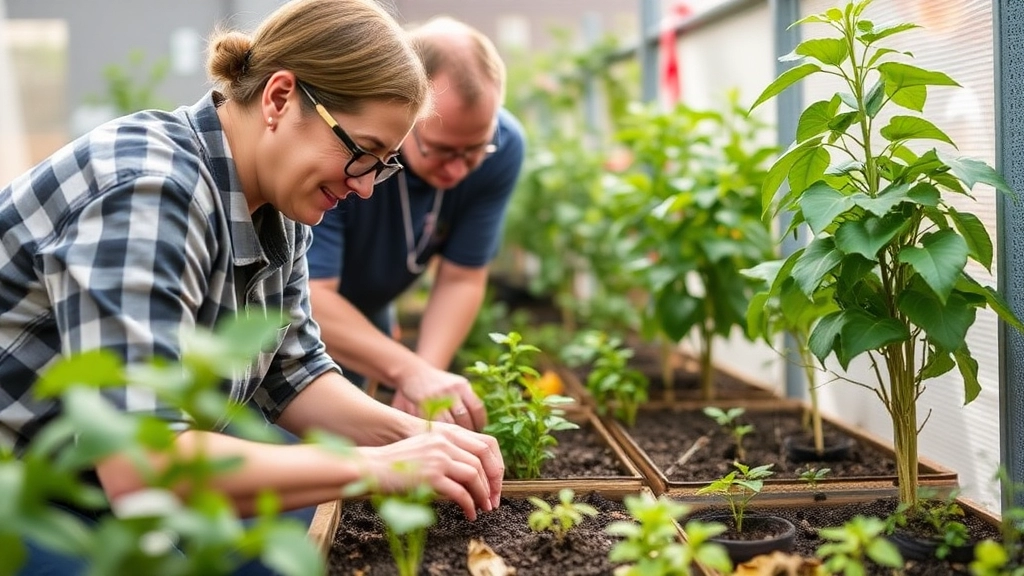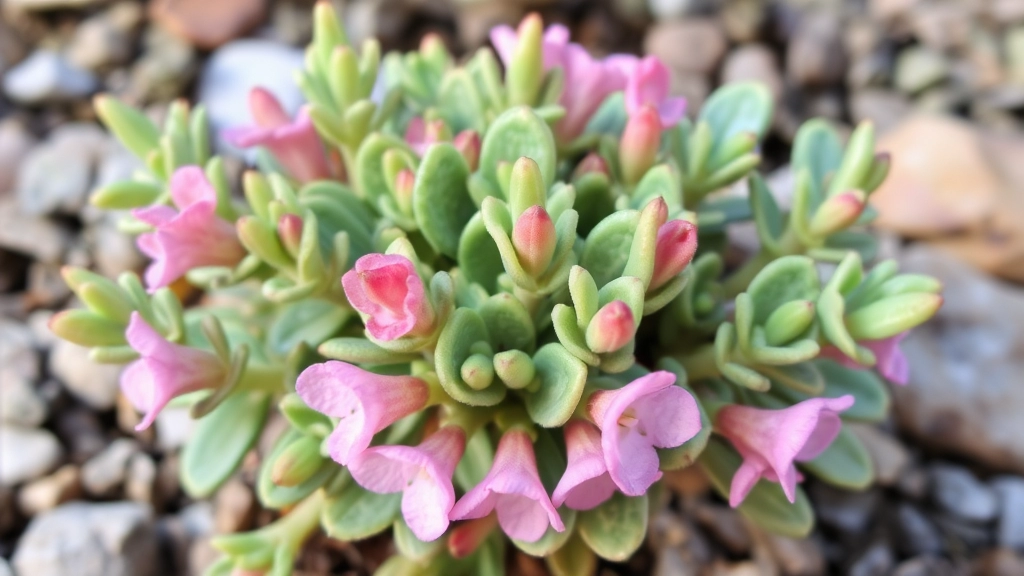Welcome to the fascinating world of Kalanchoe linearifolia
A unique succulent that’s capturing the hearts of plant enthusiasts everywhere. In this article, we’ll explore the distinctive characteristics of this Madagascar native, from its grass-like leaves to its impressive drought resistance. Whether you’re a seasoned plant parent or just starting out, you’ll discover why this low-maintenance beauty is worth adding to your collection.
What You Will Learn
We’ll dive into everything you need to know about Kalanchoe linearifolia – its natural habitat, growing conditions, propagation methods, and even its uses in landscaping. Get ready to uncover the secrets of successfully cultivating this resilient plant and learn how it compares to its Kalanchoe cousins. By the end, you’ll be equipped with all the knowledge you need to help your Kalanchoe linearifolia thrive.
Overview of Kalanchoe linearifolia
Let’s dive into Kalanchoe linearifolia, shall we?
This little gem’s been turning heads in the succulent world.
It’s not your average plant, trust me.
Kalanchoe linearifolia hails from Madagascar, like many of its cousins.
But it’s got a unique flair that sets it apart.
Think long, slender leaves that look almost grass-like.
That’s where it gets its name – ‘linearifolia’ means linear leaves.
Now, I’ve seen my fair share of succulents, but this one’s special.
It’s not just about looks, though.
This plant’s got some serious survival skills.
Drought-resistant? Check.
Low-maintenance? Double-check.
It’s like the Bear Grylls of the plant world, adapting to tough conditions.
But here’s the kicker – it’s not just tough, it’s pretty too.
When it blooms, you’re in for a treat.
Tiny, star-shaped flowers that pack a punch.
So, whether you’re a seasoned plant parent or just starting out, Kalanchoe linearifolia is worth a look.
It’s a plant that keeps on giving, without asking for much in return.
And isn’t that what we all want in a green companion?
Kalanchoe linearifolia is a fascinating succulent with unique characteristics. Its long, narrow leaves are arranged in a spiral pattern around the stem, giving it a distinctive appearance. When it comes to flowering, this plant puts on quite a show. Similar to its relative, the Kalanchoe blossfeldiana, it produces clusters of small, tubular flowers in shades of yellow, orange, or red, typically blooming in late winter or early spring.
The plant’s growth habit is relatively slow, making it an excellent choice for container gardening or rock gardens. Its shallow root system is typical of succulents, allowing it to thrive in various settings. If you’re interested in propagating this plant, you might find it helpful to learn about propagating Kalanchoe blossfeldiana from cuttings, as the process is similar for many Kalanchoe species.
Understanding these botanical characteristics is crucial for providing proper care and ensuring your Kalanchoe linearifolia thrives in your garden or indoor space.
Natural Habitat and Distribution
Ever wondered where Kalanchoe linearifolia calls home?
Let’s dive into its natural stomping grounds.
This succulent’s a native of Madagascar, that big island off Africa’s east coast.
It’s not spread all over, though. Kalanchoe linearifolia sticks to specific spots.
You’ll find it in the central and southern parts of Madagascar.
These areas are known for their unique climate and terrain.
Think rocky outcrops and dry, sunny hillsides.
The plant’s adapted to survive in these tough conditions.
It’s used to dealing with periods of drought.
That’s why it’s got those thick, water-storing leaves.
In its natural habitat, Kalanchoe linearifolia doesn’t face much competition.
It’s found a niche where not many other plants can thrive.
The plant’s distribution is pretty limited outside Madagascar.
You won’t find it growing wild in many other places.
But plant enthusiasts have spread it around the globe.
Now you can spot it in gardens and collections worldwide.
Just remember, it still needs conditions similar to its Madagascar home.
So, if you’re thinking of growing it, try to mimic its natural environment.
That’s the key to keeping your Kalanchoe linearifolia happy and healthy.
Growing Conditions and Care Requirements

Alright, let’s dive into how to keep your Kalanchoe linearifolia happy and thriving. Trust me, it’s not rocket science, but there are a few key things you’ll want to nail down.
Light: The Sun’s Best Friend
These succulents are sun-worshippers, no doubt about it. They’re practically begging for that bright, direct sunlight. But hey, if you’re in a scorching hot area, a bit of afternoon shade won’t hurt. Think of it like giving your plant a little siesta during the hottest part of the day.
Soil: Well-Draining is the Name of the Game
Here’s the deal with soil – Kalanchoe linearifolia hates wet feet. You want a mix that drains faster than your bank account on payday. I’m talking:
- Cactus potting mix
- Regular potting soil with added perlite or sand
- Anything that doesn’t hold water like a sponge
Water: Less is More
Listen, overwatering is the kiss of death for these guys. You’re better off forgetting to water than drowning them. Here’s my rule of thumb:
- Let the soil dry out completely between waterings
- Water deeply, but infrequently
- Cut back even more in winter
Temperature: Keep it Warm
Kalanchoe linearifolia isn’t built for the cold. It’s like that friend who’s always cold – keep it above 10°C (50°F) and you’re golden. If you live somewhere chilly, bring it inside when the temperature drops.
Humidity: Not a Big Deal
Good news for those of us who can’t be bothered with humidifiers – these plants don’t need high humidity. They’re pretty chill about average room humidity.
Fertiliser: A Little Boost Goes a Long Way
During the growing season (spring and summer), give your Kalanchoe linearifolia a bit of low-nitrogen fertiliser. It’s like a protein shake for plants – helps them grow strong without getting too lanky.
Pruning: Keep it in Shape
Don’t be afraid to give your plant a haircut now and then. Pinch off the growing tips to encourage bushiness, and remove any dead or yellowing leaves. It’s like a spa day for your plant.
Remember, the key to growing Kalanchoe linearifolia successfully is to mimic its natural habitat. Think hot, dry, and sunny. Get these basics right, and you’ll have a thriving, beautiful succulent on your hands in no time. If you’re looking for another interesting Kalanchoe variety, check out the Kalanchoe tomentosa ‘Dorothy’, known for its fuzzy leaves. For those interested in medicinal uses, the medicinal Kalanchoe pinnata is worth exploring.
Propagation Methods
Alright, let’s talk about how to make more Kalanchoe linearifolia plants. It’s easier than you might think!
Leaf Cuttings: The Lazy Way
Ever noticed those little leaves that fall off? Don’t toss ’em!
- Just lay them on some well-draining soil
- Mist occasionally
- Watch tiny plants sprout in a few weeks
It’s like magic, but it’s just science, baby.
Stem Cuttings: The Quick Way
Got pruning shears? Let’s do this:
- Cut a healthy stem, about 4 inches long
- Remove lower leaves
- Let it dry for a day (callus formation, fancy talk for scab)
- Stick it in moist, well-draining soil
- Keep it warm and slightly moist
Boom! New plant in about a month.
Seeds: The Patient Way
Not gonna lie, this takes time. But if you’re into delayed gratification:
- Collect seeds from mature flowers
- Sow on top of well-draining soil
- Keep warm and moist
- Wait… and wait some more
Seedlings pop up in a few weeks, but it’ll be a while before you’ve got a full-grown plant.
Division: The “Two for One” Way
Got a big, bushy Kalanchoe linearifolia? Lucky you!
- Carefully dig it up
- Gently separate the roots
- Replant each section
Instant plant multiplication. It’s like cloning, but way less sci-fi.
Remember, whichever method you choose, patience is key. These succulents aren’t in a rush, so why should you be?
Propagating Kalanchoe linearifolia is a fun way to expand your collection or share with friends. Give it a shot!
Common Pests and Diseases

Let’s chat about the not-so-fun part of growing Kalanchoe linearifolia – the pests and diseases that can mess with your plant. Trust me, I’ve been there, and it’s no picnic. But don’t worry, I’ve got your back.
Pesky Critters to Watch Out For
- Mealybugs: These little cotton-ball lookalikes love to suck the life out of your plant. Literally.
- Spider mites: Tiny but terrible, they’ll leave your plant looking like it’s covered in cobwebs.
- Aphids: Small, green, and always hungry for your Kalanchoe’s sap.
Diseases That’ll Make You Go “Ugh”
- Root rot: Too much water? Your plant’s roots might turn to mush.
- Powdery mildew: Looks like someone sprinkled flour on your plant. Not cool.
- Leaf spot: Brown spots on leaves? Yeah, that’s not supposed to happen.
Now, I know what you’re thinking. “Great, now I’m paranoid about every little thing on my plant!” But hold up, it’s not all doom and gloom. Here’s the deal:
Prevention is Your Best Mate
- Keep it clean: Wipe those leaves down occasionally. It’s like a spa day for your plant.
- Don’t overwater: Seriously, it’s like drowning your plant in kindness. Easy does it.
- Good air flow: Your Kalanchoe needs to breathe, just like you do after running for the bus.
When Trouble Strikes
If you spot something funky, don’t panic. Here’s what you can do:
- For pests: A bit of neem oil or insecticidal soap can work wonders. It’s like pest kryptonite.
- For diseases: Snip off the affected parts and adjust your care routine. Sometimes, less is more.
Remember, your Kalanchoe linearifolia is tougher than it looks. With a bit of TLC and a watchful eye, you’ll keep those pests and diseases at bay. And if all else fails, well, that’s what plant shops are for, right?
Keep an eye out for these common pests and diseases, and your Kalanchoe linearifolia will thank you by thriving and looking fabulous. It’s all about staying one step ahead of the game. If you’re interested in other Kalanchoe varieties, check out the Kalanchoe tomentosa varieties or learn about the flowering period of Kalanchoe blossfeldiana for more diverse options in your plant collection.
Uses and Benefits in Landscaping
Kalanchoe linearifolia: Your Secret Weapon for Stunning Landscapes
Ever wondered how to make your garden pop without breaking a sweat?
Enter Kalanchoe linearifolia, the unsung hero of low-maintenance landscaping.
This little beauty’s got some serious perks up its sleeve.
First off, it’s a drought-tolerant champ.
Forget constant watering – this plant’s happy with a sip here and there.
Perfect for those of us who aren’t exactly green-thumbed, right?
But wait, there’s more!
Its unique linear leaves add a touch of modern flair to any garden.
Think sleek, think chic, think “wow, where’d you get that plant?”
Rock gardens? It’s a match made in heaven.
Succulent gardens? It’ll fit right in.
Container planting? Oh, you bet.
And here’s the kicker – it’s got these gorgeous flowers that bloom for ages.
We’re talking weeks, sometimes months of colour.
No more sad, flowerless patches in your garden.
But here’s my favourite bit:
It’s a proper tough cookie.
Harsh sun? No problem.
Poor soil? It’ll manage.
Neglect? It’ll forgive you (within reason, of course).
So, whether you’re a busy bee or just starting out, Kalanchoe linearifolia’s got your back.
It’s like the Swiss Army knife of plants – versatile, reliable, and always impressive.
Ready to give your landscape a facelift without the fuss?
Kalanchoe linearifolia might just be your new best mate in the garden.
Tips for Successful Cultivation

Alright, let’s dive into how to keep your Kalanchoe linearifolia thriving like a champ. Trust me, I’ve had my fair share of plant mishaps, but these tips will help you avoid the common pitfalls.
Soil and Drainage: The Secret Sauce
First things first, these succulents are all about that well-draining soil life. Here’s what I do:
- Mix regular potting soil with some perlite or sand
- Aim for a 50/50 ratio – it’s not rocket science, just eyeball it
- Make sure your pot has drainage holes – no one likes wet feet, especially not Kalanchoe
Light: Let There Be Brightness
These guys are sun-worshippers, but they’re not masochists. Here’s the deal:
- Bright, indirect light is the sweet spot
- A few hours of morning sun won’t hurt
- If you’re keeping them indoors, a south-facing window is your best bet
Watering: Less is More
Overwatering is the number one killer of succulents. Don’t be that person. Here’s my watering strategy:
- Wait until the soil is completely dry before watering
- In summer, this might be once a week
- In winter, you might get away with once a month
- When in doubt, don’t water – these plants are tough cookies
Temperature: Keep it Cozy
Kalanchoe linearifolia isn’t a fan of extreme temperatures. Think Goldilocks – not too hot, not too cold. Here’s what works:
- Ideal range: 15-25°C (59-77°F)
- Can tolerate brief periods below 10°C (50°F), but don’t push it
- Protect from frost – these aren’t Arctic explorers
Fertilizer: A Little Boost Goes a Long Way
These plants aren’t big eaters, but a little nutrients now and then won’t hurt. My approach:
- Use a balanced, water-soluble fertilizer
- Feed once a month during the growing season (spring and summer)
- Dilute the fertilizer to half-strength – less is more
Pruning: Keeping it Tidy
Kalanchoe linearifolia doesn’t need much pruning, but a little grooming can go a long way:
- Remove dead or yellowing leaves
- Trim back leggy growth to encourage bushiness
- Use clean, sharp scissors to avoid damaging the plant
Remember, successful cultivation of Kalanchoe linearifolia is all about mimicking its natural habitat. Keep it sunny, keep it dry, and don’t fuss over it too much. These plants are survivors – they’ll thank you for not killing them with kindness. If you’re interested in other Kalanchoe varieties, check out the Kalanchoe blossfeldiana, also known as the Flaming Katy. For those looking for a unique variety, the Kalanchoe tomentosa ‘Teddy Bear’ is a charming option with its fuzzy leaves.
Comparisons with Other Kalanchoe Species
Let’s chat about Kalanchoe linearifolia and how it stacks up against its cousins.
Ever wondered what makes this plant stand out in the Kalanchoe family?
Well, I’ve got some juicy insights for you.
First off, Kalanchoe linearifolia is a bit of a rebel.
Unlike its plump-leaved relatives, it’s got these slender, linear leaves.
Think of it as the supermodel of the Kalanchoe world – tall and slim.
Now, compare that to the chubby leaves of Kalanchoe blossfeldiana.
It’s like comparing a pencil to a marshmallow!
But here’s where it gets interesting:
- Growth habit: K. linearifolia is more upright and less bushy
- Flower shape: Its blooms are more star-like than other species
- Drought tolerance: This bad boy can handle dry spells like a champ
Now, let’s talk about Kalanchoe daigremontiana, aka Mother of Thousands.
That one’s a baby-making machine, sprouting plantlets like there’s no tomorrow.
K. linearifolia? It’s more chill about reproduction.
It’s not trying to take over your garden overnight.
Here’s a quick comparison table for you:
| Feature | K. linearifolia | K. blossfeldiana | K. daigremontiana |
|---|---|---|---|
| Leaf shape | Linear | Oval | Triangular |
| Reproduction | Moderate | Slow | Rapid |
| Height | Tall | Short | Medium |
See the difference? It’s like comparing apples, oranges, and… well, Kalanchoes!
But here’s the kicker – K. linearifolia is often overlooked.
It’s the underdog of the Kalanchoe world, if you ask me.
While others are flashy with their colours, this one’s got subtle charm.
It’s like that quiet friend who surprises you with their wit.
So, next time you’re plant shopping, give K. linearifolia a second look.
It might just be the unique addition your garden needs.
Remember, in the world of Kalanchoes, K. linearifolia is the cool, laid-back cousin.
It’s got its own style, and it’s not afraid to show it.
Frequently Asked Questions about Kalanchoe linearifolia
Alright, let’s dive into some burning questions about Kalanchoe linearifolia. I’ve chatted with loads of plant enthusiasts, and these are the queries that keep popping up. No fluff, just straight-up answers to help you nail your Kalanchoe game.
Is Kalanchoe linearifolia hard to grow?
Nah, it’s pretty chill. These succulents are tough cookies. They’re not fussy about soil and can handle a bit of neglect. Perfect for busy folks or newbie plant parents.
How often should I water my Kalanchoe linearifolia?
Here’s the deal: less is more. These guys hate wet feet. Water when the soil’s bone dry, usually every 2-3 weeks. In winter, cut back even more.
Can Kalanchoe linearifolia survive outdoors?
Sure thing, if you’re in the right spot. They love warm climates (USDA zones 10-11). But if you’re somewhere chilly, keep ’em indoors or pop them outside for summer vacays.
What’s the best way to propagate Kalanchoe linearifolia?
Leaf cuttings, all the way. Snip a healthy leaf, let it callus for a day or two, then stick it in some well-draining soil. Boom, new plant in a few weeks.
My Kalanchoe linearifolia’s leaves are turning yellow. What’s up?
Usually, it’s overwatering. Ease up on the H2O, mate. If the soil’s soggy, repot in fresh, dry mix. Yellow leaves can also mean too much sun, so check its light situation.
Does Kalanchoe linearifolia flower?
Yep, but don’t hold your breath. They’re not known for frequent blooming. When they do, expect small, star-shaped flowers in clusters.
Is Kalanchoe linearifolia toxic to pets?
Sadly, yes. Keep it out of reach of curious paws and muzzles. If ingested, it can cause vomiting and other nasty stuff.
How big does Kalanchoe linearifolia get?
It’s not a giant. Expect it to reach about 30-60 cm tall and wide. Perfect for small spaces or as part of a succulent gang.
Can I grow Kalanchoe linearifolia from seeds?
You can, but it’s a slow road. Leaf cuttings are way quicker and easier. If you’re set on seeds, be patient and keep them warm and moist until they sprout.
How do I know if my Kalanchoe linearifolia is healthy?
Look for firm, plump leaves with a bluish-green hue. No mushy bits, no brown spots. If it’s stretching out, it might need more light. Happy Kalanchoe, happy life.
There you have it, folks. The lowdown on Kalanchoe linearifolia. Keep these tips in mind, and you’ll be a Kalanchoe pro in no time. Remember, these plants are pretty forgiving, so don’t stress too much. Just give ’em some love (but not too much water), and they’ll thrive.
Frequently Asked Questions about Kalanchoe linearifolia
1. What makes Kalanchoe linearifolia unique among succulents?
Kalanchoe linearifolia stands out with its long, slender leaves that resemble grass blades. This unique leaf shape sets it apart from other more common succulent varieties with plump, fleshy leaves.
2. How much light does Kalanchoe linearifolia need?
This plant thrives in bright, indirect light. While it can tolerate some direct sunlight, especially in the morning, too much intense sun can scorch its leaves. A spot near a south-facing window with filtered light is ideal.
3. Is Kalanchoe linearifolia suitable for beginners?
Absolutely! Its low-maintenance nature and drought-tolerance make it an excellent choice for novice plant enthusiasts. It’s forgiving of occasional neglect and doesn’t require frequent watering.
4. Can Kalanchoe linearifolia be grown indoors?
Yes, it adapts well to indoor environments. Ensure it receives adequate light and maintain proper air circulation. It’s an excellent choice for offices or homes with limited outdoor space.
5. How often should I fertilize my Kalanchoe linearifolia?
Fertilize sparingly during the growing season (spring and summer) with a balanced, water-soluble fertilizer diluted to half strength. Once every 4-6 weeks is usually sufficient. Avoid fertilizing in winter when growth slows down.
6. What’s the best soil mix for Kalanchoe linearifolia?
Use a well-draining soil mix specifically designed for succulents or cacti. You can also create your own by mixing regular potting soil with perlite or coarse sand to improve drainage.
7. How do I propagate Kalanchoe linearifolia?
The easiest method is through leaf cuttings. Simply remove a healthy leaf, allow the cut end to callus for a day or two, then place it on well-draining soil. Roots and a new plant will develop from the base of the leaf.
8. Does Kalanchoe linearifolia have any medicinal properties?
While some Kalanchoe species are known for medicinal uses, there’s limited research on Kalanchoe linearifolia’s specific properties. It’s best to enjoy it as an ornamental plant rather than for medicinal purposes.
9. How can I encourage my Kalanchoe linearifolia to bloom?
Provide it with a period of cooler temperatures and reduced watering in late fall to early winter. This mimics its natural dormancy period and can trigger blooming in late winter or early spring.
10. Is Kalanchoe linearifolia prone to any specific pests or diseases?
While generally resistant, it can be susceptible to mealybugs and root rot if overwatered. Regular inspection and proper watering practices are key to preventing these issues.
References
-
Kalanchoe linearifolia – World Flora Online http://www.worldfloraonline.org/taxon/wfo-0000361326

